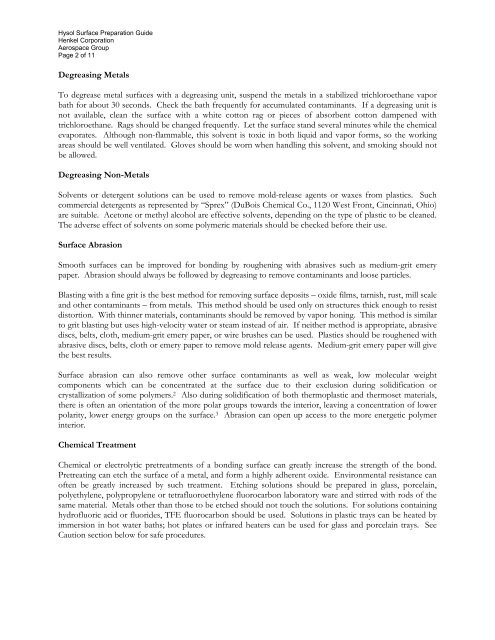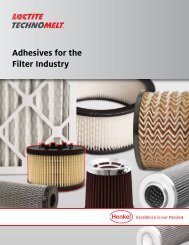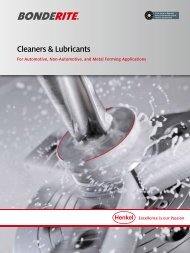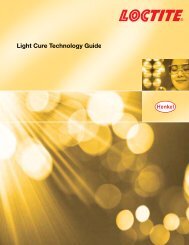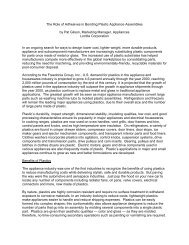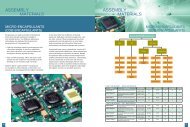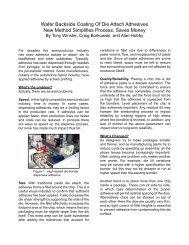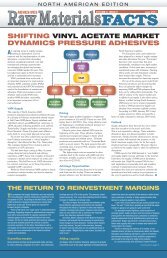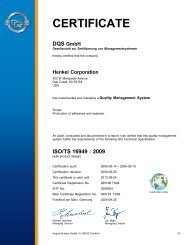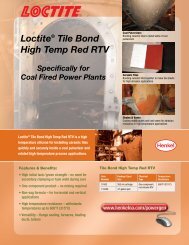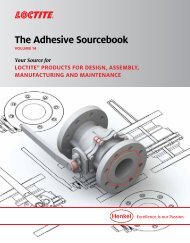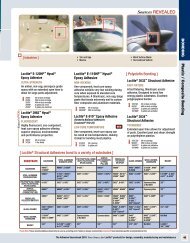Hysol® Surface Preparation Guide
Hysol® Surface Preparation Guide
Hysol® Surface Preparation Guide
You also want an ePaper? Increase the reach of your titles
YUMPU automatically turns print PDFs into web optimized ePapers that Google loves.
Hysol <strong>Surface</strong> <strong>Preparation</strong> <strong>Guide</strong><br />
Henkel Corporation<br />
Aerospace Group<br />
Page 2 of 11<br />
Degreasing Metals<br />
To degrease metal surfaces with a degreasing unit, suspend the metals in a stabilized trichloroethane vapor<br />
bath for about 30 seconds. Check the bath frequently for accumulated contaminants. If a degreasing unit is<br />
not available, clean the surface with a white cotton rag or pieces of absorbent cotton dampened with<br />
trichloroethane. Rags should be changed frequently. Let the surface stand several minutes while the chemical<br />
evaporates. Although non-flammable, this solvent is toxic in both liquid and vapor forms, so the working<br />
areas should be well ventilated. Gloves should be worn when handling this solvent, and smoking should not<br />
be allowed.<br />
Degreasing Non-Metals<br />
Solvents or detergent solutions can be used to remove mold-release agents or waxes from plastics. Such<br />
commercial detergents as represented by “Sprex” (DuBois Chemical Co., 1120 West Front, Cincinnati, Ohio)<br />
are suitable. Acetone or methyl alcohol are effective solvents, depending on the type of plastic to be cleaned.<br />
The adverse effect of solvents on some polymeric materials should be checked before their use.<br />
<strong>Surface</strong> Abrasion<br />
Smooth surfaces can be improved for bonding by roughening with abrasives such as medium-grit emery<br />
paper. Abrasion should always be followed by degreasing to remove contaminants and loose particles.<br />
Blasting with a fine grit is the best method for removing surface deposits – oxide films, tarnish, rust, mill scale<br />
and other contaminants – from metals. This method should be used only on structures thick enough to resist<br />
distortion. With thinner materials, contaminants should be removed by vapor honing. This method is similar<br />
to grit blasting but uses high-velocity water or steam instead of air. If neither method is appropriate, abrasive<br />
discs, belts, cloth, medium-grit emery paper, or wire brushes can be used. Plastics should be roughened with<br />
abrasive discs, belts, cloth or emery paper to remove mold release agents. Medium-grit emery paper will give<br />
the best results.<br />
<strong>Surface</strong> abrasion can also remove other surface contaminants as well as weak, low molecular weight<br />
components which can be concentrated at the surface due to their exclusion during solidification or<br />
crystallization of some polymers. 2 Also during solidification of both thermoplastic and thermoset materials,<br />
there is often an orientation of the more polar groups towards the interior, leaving a concentration of lower<br />
polarity, lower energy groups on the surface. 3 Abrasion can open up access to the more energetic polymer<br />
interior.<br />
Chemical Treatment<br />
Chemical or electrolytic pretreatments of a bonding surface can greatly increase the strength of the bond.<br />
Pretreating can etch the surface of a metal, and form a highly adherent oxide. Environmental resistance can<br />
often be greatly increased by such treatment. Etching solutions should be prepared in glass, porcelain,<br />
polyethylene, polypropylene or tetrafluoroethylene fluorocarbon laboratory ware and stirred with rods of the<br />
same material. Metals other than those to be etched should not touch the solutions. For solutions containing<br />
hydrofluoric acid or fluorides, TFE fluorocarbon should be used. Solutions in plastic trays can be heated by<br />
immersion in hot water baths; hot plates or infrared heaters can be used for glass and porcelain trays. See<br />
Caution section below for safe procedures.


